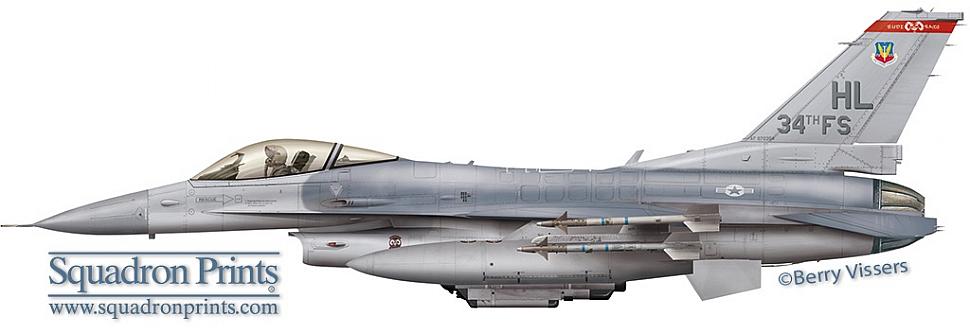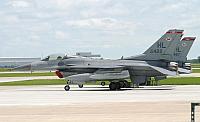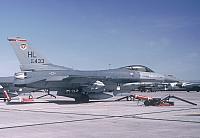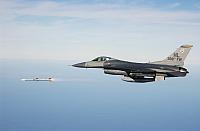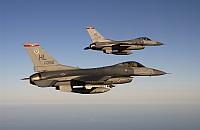 |
34th Fighter Squadron ( USAF ACC)" Rams" |
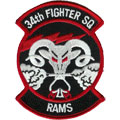 |
34 FS " Rams" ( USAF ACC) | |||
| Status: |
Converted
|
|||
| Version: | F-16C/D block 40 | |||
| Role: | Attack | |||
| Tailband: | Red | |||
| Motto: | The Men in Black | |||
| Badge: | N/A | |||
|
Converted to the F-35A in 2015.
|
||||
F-16 History
The 34th FS was one of the first units within the USAF to receive the F-16. New block 1, 5 and 10 airframes came straight from the General Dynamics production line at Fort Worth starting in 1979. At first the squadron was tasked with an overall F-16 training duty. Pilots from the US, Belgium, Denmark, The Netherlands, Norway and Israel came to it to get their tactical skills on the F-16 on a higher level.
Later on the squadron was tasked with conventional air-to-ground and attack, although the first aircraft were in fact airframes that still had the small stabilizers. Since the importance of the squadron for this task, newer block 15 airframes came into the unit quite quickly. By 1982 the squadron was completely converted to the block 15 airframes. The 34th kept flying with these airframes in the same roll up until 1989. It was then that they started receiving the upgraded block 40 version of the F-16. With this newer version the squadron was able to conduct its missions with even greater accuracy and eventually added the night-time capability.
This night opreations came into being with the introduction of the Low Altitude Navigation and Targeting Infrared for Night (LANTIRN) pod to the inventory. The squadron started operating this pod in mid 1989 as one of the first USAF squadrons to deploy it in an operational environment. With tensions rising in the Middle East the squadron had to adopt this new weapon system very quickly and had to train in very different scenarios then previously flown in a couple of months time.
By 2010 the USAF decided to reduce the overall amount of F-16 units throughout the air force. Since there were three squadrons at Hill AFB it was decided to disband one of them and disperse the block 40 airframes to other units that were in need of them. The 34th FS was ultimately chosen to be disbanded and this finally happened on July 16th, 2010 ending an F-16 career spanning over 30 years.
Aircraft Markings History
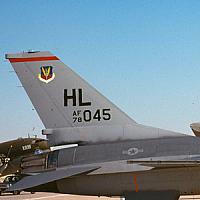
The tails consist of a red tailband. The 'HL' tailcode (from Hill) is in the center of the tail with the Tactical Air Command logo in between. The serial is underneath the tailcode.
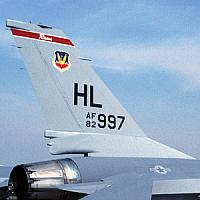
The general lay-out remained the same, but the word 'Ram' was added in the tailband.

Also the last change of the tail scheme was minor. The word 'Ram' in the tailband was replaced by the squadron logo with the words 'Rude Rams' next to it on both sides.
Unit History
- 1944: Activation of the squadron in Seymour Johnson, North Carolina
- 1944: P-47 'Thunderbolt' (part of 413 FG)
- 1944: P-47 'Thunderbolt' (Bluethenthal Field, North Carolina)
- 1945: P-47 'Thunderbolt' (Shima Field [Jap.])
- 1945: P-47 'Thunderbolt' (Kadena AB [Jap.])
- 1946: P-47 'Thunderbolt' (Yontan AB [Jap.])
- 1946: Disbanded
- 1954: Activation of the squadron in George, California
- 1954: F-86 'Sabre' (part of 413 FDG)
- 1956: F-100 'Super Sabre'
- 1957: F-100 'Super Sabre' (part of 413 FDW)
- 1958: F-100 'Super Sabre' (part of 413 TFW)
- 1959: Disbanded
- 1966: Activation of the squadron in Korat [Thai.]
- 1966: F-105D 'Thunderchief' (part of 41 AD)
- 1968: F-105D 'Thunderchief' (part of 347 TFW)
- 1969: F-4D 'Phantom II'
- 1971: F-4D 'Phantom II' (part of 388 TFW)
- 1975: F-4D 'Phantom II' (Hill AFB, Utah)
- 1979: F-16A/B 'Fighting Falcon'
- 1989: F-16C/D 'Fighting Falcon'
- 1991: F-16C/D 'Fighting Falcon' (part of 388 OG)
- 2010: Disbanded
Deployments
 |
' Desert Storm' |
| Zaragoza AB, Spain (October of 1990 to March of 1991) | |
| The 34th TFS didn't actually operate in the war, but it was put in a forward location in Spain to act as support squadron for the operational units in the Middle East. | |
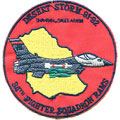 |
' Southern Watch' |
| King Abdul Aziz AB, Saudi Arabia (December of 1991 to April of 1992) | |
| The squadron was tasked to deploy to Saudi Arabia after operation Desert Storm was finished. Although already an operation Southern Watch mission, the patch still showed operation Desert Storm titles. | |
 |
' Southern Watch' |
| King Abdul Aziz AB, Saudi Arabia (January of 1993 to March of 1993) | |
| This was the second deployment of the squadron to the south of Iraq. Operation Southern Watch was an operation which was responsible for enforcing the United Nations mandated no-fly zone below the 32nd parallel in Iraq. This mission was initiated mainly to cover for attacks of Iraqi forces on the Iraqi Shi’ite Muslims. | |
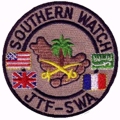 |
' Southern Watch' |
| Prince Sultan AB, Saudi Arabia (January of 1995 to April of 1995) | |
| In their third deployment the 34th sent up to 300 personnel for this mission. They were relieved from the mission by their sister squadron, the 4th FS. | |
 |
' Southern Watch' |
| Prince Sultan AB, Saudi Arabia (June 15th, 1996 to October of 1996) | |
| Once again the 34th FS was sent to the Gulf region to perform an operation Southern Watch mission to guard the southern airspace of Iraq. | |
 |
' Southern Watch/Desert Fox' |
| Ahmad al-Jaber AB, Kuwait (November of 1998 to February of 1999) | |
| During the Rams last Southern Watch deployment, they flew combat missions during Operation Desert Fox in a move to strike Iraqi targets which contributed to its ability to produce and deliver weapons of mass destruction. A total of 23 combat mission were flown. | |
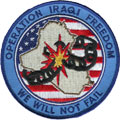 |
' Iraqi Freedom' |
| Balad AB, Iraq (May of 2008 to October 5th, 2008) | |
| Over 300 airman from the 34th FS deployed to Iraq to take over after the 421st FS. A grand total of 1,700 combat missions were flown by the squadron. All three squadrons rotated through the desert, first the 4th FS in August of 2007, then the 421st FS followed by the 34th FS which all totaled over one year in the desert with the 34th FS returning in October of 2008. Aircraft were shared between the squadron and remained in theatre the entire time. Hill AFB squadrons flew over 5,000 combat missions and were involved in over 200 engagements. | |
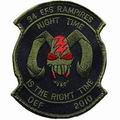 |
' Enduring Freedom' |
| Bagram AB, Afghanistan (January 23rd, 2010 to May 21st, 2010) | |
| Replaced the 79th FS with about 260 people from Hill AFB. Noteworthy was F-16C #89-2119 which flew 40 consecutive missions without a failure landing code 1 each time. This a rare thing for modern aircraft. Unfortunately the 34th FS returned home and was deactivated shortly after on July 16th, 2010. |
F-16 Airframe Inventory
- All 34 FS F-16s in our F-16 Aircraft Database (past and current aircraft)
- Current 34 FS F-16s in our F-16 Aircraft Database
Photos
Please use this form to add any list any error or omissions you find in the above text.
Note: your comments will be displayed immediately on this page. If you wish to send a private comment to the webmasters, please use the Contact Us link.

